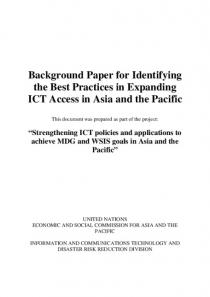During the past decade, Asia and the Pacific region has experienced continuous Information and Communication Technology (ICT) infrastructure developments. ICT penetration in major cities in most of the countries has been fulfilled; however, in rural areas it is far below satisfactory levels and many people in those regions still do not have access to ICT.
The digital divide still is a serious problem in Asia and the Pacific, since the region has extremely diverse income, population size, and geographical features, ranging from land-locked regions in the area of Himalayas and Central Asia to isolated islands in the Pacific. According to the latest ESCAP figures, over 50 out of 100 populations in the ESCAP region have mobile connection access, on average. However, when the figure is disaggregated, stark sub-regional and sub-national disparities become obvious.
Fiber optic cables have become indispensable backbone connections among the countries, while emerging wireless and space technology present good approaches to broaden coverage where the broadband cannot reach. Therefore, technology is ready to penetrate any area around the world. The key issue to bridging digital divide is how to reach Last Mile by using combinations of latest technologies and overcome various socio-economic barriers which prohibit wider ICT access.

